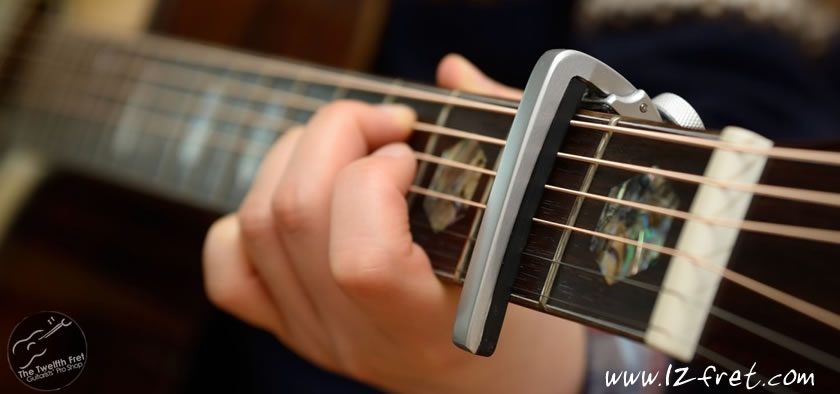
The Capo is Often Misunderstood Or Dismissed As A Cheater
Often misunderstood or dismissed as a “cheater”, the capo is basically a bar that’s clamped across the fingerboard. It is a very useful tool that quickly solves a common problem: What do you do when you have to play a song in another key – RIGHT NOW – and transposing the chords doesn’t work or isn’t practical?
Simply place the capo on the correct fret and use the chord patterns as before. You’re ready to go in moments.
Far from being a “cheater”, the capo allows a number of things that are hard to achieve otherwise. Placing a capo on the 3rd or 5th fret and playing open position chords creates a higher pitched, open and “airy” sound. If you are playing with a singer or another instrument that’s more comfortable in another key, pop the capo on and you’re ready to go.
A number of traditional blues guitarists tuned their guitar strings down, and then used a capo to get up to another pitch.
For example, for many tunes such as “Kind Hearted Woman Blues”, “Ramblin’ On My Mind” and “Come On in My Kitchen”, Robert Johnson tuned the guitar down one half step (to E flat), then put a capo on the 2nd fret so that the ‘open’ low string was F sharp. This would not only change the key of the song, but reduce the string tension.
The distinctive guitar sound on the Beatles tune “Here comes the sun” involves having a capo on the 7th fret.
In addition, with a capo in use, stretches between notes will be shorter so a chord spanning several frets will be easier to reach and play.
Capos generally span the entire fingerboard, but that’s not always necessary. It’s quite possible to purchase or modify capos that act on only a few strings, and with one or more these, you can very quickly change to an ‘open tuning’ without actually retuning the guitar or having to have a guitar for each tuning.
It must be said that there is a circumstance where capos don’t work very well, and that’s when a vibrato tailpiece is used. To stay in tune, these units require either the smallest amount of friction wherever the string touches, or a complete lockdown. A capo introduces a lot of friction, but not so much that the strings are locked, and so tuning problems are almost certain to arise.
How Capos Work
At its minimum, a capo is a bar strapped across the neck, like a movable nut or a finger used for barre chords.
Some players have used pencils and elastics when nothing else is available, but much better models are available.
There are three basic types of capo: elastic or strap models, cam/lever capos, and c-clamp. The bar itself comes in different profiles for use on classical (flat fingerboard) guitars, or steel-string (arched fingerboard) guitars.
There is a fourth type of capo almost exclusively used on 5-string banjos. The 5th string capo runs along a rail that’s screwed to the side of the neck, and the capo surface is moved to an appropriate fret. A banjo’s 5th string is commonly used as a drone and never fretted, so this allows a quick key change without taking the time to retune the string to another pitch (and possibly break it).
There are sizes available for all types of instruments; wide ones for 12-string guitars and very narrow capos for mandolins. There are also variations for other instruments, such as the Shubb capo for resonator guitars, which clamps above and below the strings (since these guitars may not even have frets, and if they are there they’re never used).
Elastic/strap models wrap around the neck and use the tension of the fabric to hold the bar down.
Cam / lever types use a spring and cam arrangement to provide tension for the bar.
C-Clamp types use a setscrew to provide tension.
